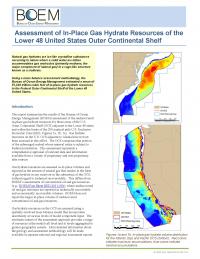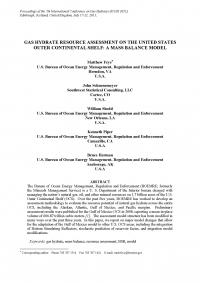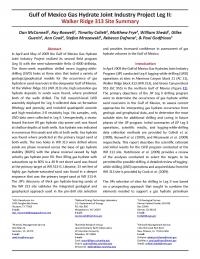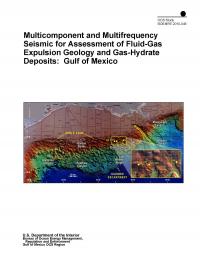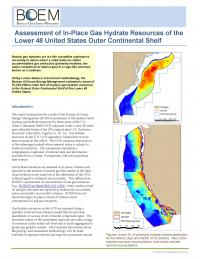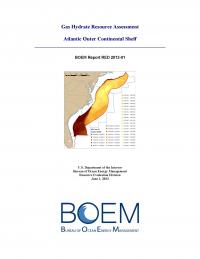Gas hydrates are ice-like crystalline substances occurring in nature where a solid water lattice accommodates gas molecules (primarily methane, the major component of natural gas) in a cage-like structure, also known as clathrate. These form under conditions of relatively high pressure and low temperatures, such as those found in the shallow subsurface under many of the world's deep-water oceans. The amount of natural gas in methane hydrate worldwide is estimated to be far greater than the entire world's conventional natural gas resources. BOEM, in conjunction with our U.S. government partners, industry, and numerous universities, has an ongoing effort to better understand the distribution of methane hydrates on the OCS.
Resources and Publications
- Gas Hydrates - Resource Assessments
- Gas Hydrates - Technical Recoverability Studies
- Ohio State University Prospect Analysis
- MATRIX Project
- University of Texas GOM2
- Stanford University BPSM
- Scripps Institute of Oceanography CSEM
- Gulf of America Gas Hydrate Joint Industry Project
- Gulf of America Seafloor Observatory
The BOEM gas hydrate assessment model was initially developed for the GOM OCS over a period of approximately five years (2003 – 2008). A preliminary assessment of the in-place gas hydrate resources was published in OCS Report MMS 2008-004. This report also included a complete description of the input parameters, methodologies, and modeling approach. The original GOM OCS model structure was modified slightly for the assessment of gas hydrate on the Atlantic and Pacific OCS; the results for all three of these OCS regions are summarized in the “Assessment of In-Place Gas Hydrate Resources of the Lower 48 United States Outer Continental Shelf (BOEM Fact Sheet RED-2012-01).
Assessment of In-Place Gas Hydrate Resources of the Lower 48 United States | |||
MMS Report 2008-004 | |||
BOEM Presentation at the 2012 ESRI Conference
| |||
ICGH 2011
| |||
Gas Hydrate Joint Industry Project Leg II:
| |||
OCS Study BOEMRE Report 2010-046 | |||
Gas Hydrate Resource Potential in the Terrebonne Basin, Northern Gulf of Mexico, 2011, by Frye, M., Shedd, W., and Boswell, R., Marine and Petroleum Geology, Volume 34 Issue 1, June 2012, pages 150-168.
Occurrence and Nature of “Bottom Simulating Reflectors” in the Northern Gulf of Mexico, 2011, by Shedd, W., Boswell, R., Frye, M., Godfriaux, p, and Kramer, K., Marine and Petroleum Geology, Volume 34 Issue 1, June 2012, pages 4-30.
|
The BOEM gas hydrate resource assessment model for the Pacific OCS is similar to the cell-based, mass balance approach that was initially developed for the 2008 Gulf of Mexico assessment, though a number of fundamental changes were required to reflect the Pacific OCS geologic influence on the gas hydrate petroleum system. The Pacific model employs a depofacies model for prediction of the host lithologic unit, rather than a cell-based deterministic estimate. The Pacific model introduces limitations based on the age of the underlying crust and the thickness of the sedimentary cover, both of which are partially attributable to the active seafloor spreading that is not present on the Atlantic or GOM OCS. The Pacific model introduces input variables with a combined spatial/empirical component. The BOEM model predicts the highest density accumulations of gas hydrate in-place will reside in the near-shore basins along the Pacific coast, while opportunities for moderate accumulations are present in sand-rich submarine fan deposits.
Pacific OCS model results are summarized below in BOEM Fact Sheet RED-2012-01.
Assessment of In-Place Gas Hydrate Resources of the Lower 48 United States | |
BOEM Presentation at the 2012 ESRI Conference Gas Hydrate Resource Assessment of the United States Outer Continental Shelf - BOEM Presentation at the 2012 ESRI Conference in San Diego, California | |
ICGH 2011 Gas Hydrate Resource Assessment of the United States Outer Continental Shelf: A Mass Balance Model, 2011, by Frye, M., Schuenemeyer, J., Shedd, W., Piper, K., and Herman, B., Proceedings of the 7th International Conference on Gas Hydrates (ICGH 2011), Edinburgh, Scotland, United Kingdom, July 17-21, 2011 |
At this time, BOEM is not pursuing an assessment of in-place gas resources on the Alaska OCS.
BOEM gas hydrate resource assessment model for the Atlantic OCS is similar to the cell-based, mass balance approach that was initially developed for the 2008 Gulf of Mexico assessment. The two most significant changes in modeling approach include the introduction of a Bottom Simulating Reflector (BSR) as a spatial input and the removal of the lateral, or dip-driven, component of the gas migration model. The BOEM model predicts the highest density accumulations of gas hydrate in-place will reside in the central and northern Atlantic OCS, due in large part to the greater likelihood of sandstone reservoirs in the subsurface.
Atlantic OCS model results are summarized below in BOEM Fact Sheet RED-2012-01, and complete reporting on the detail of the Atlantic OCS model is available below in BOEM Report RED 2013-01.
| Gas Hydrate Resource Assessment Atlantic outer Continental Shelf BOEM Report RED 2013-01 | |
| BOEM Fact Sheet RED-2012-01: Assessment of In-Place Gas Hydrate Resources of the Lower 48 United States Outer Continental Shelf | |
| Gas Hydrate Potential of the Mid Atlantic Outer Continental Shelf, William W. Shedd (MMS, New Orleans, LA) and Deborah R. Hutchinson (USGS, Woods Hole, MA), Published by US Dept of Energy, Fire in the Ice Methane Hydrate Newsletter, Vol. 6 Issue 3, Page 8 | |
| Gas Hydrate Resource Assessment of the United States Outer Continental Shelf: A Mass Balance Model, 2011, by Frye, M., Schuenemeyer, J., Shedd, W., Piper, K., and Herman, B., Proceedings of the 7th International Conference on Gas Hydrates (ICGH 2011), Edinburgh, Scotland, United Kingdom, July 17-21, 2011 |


